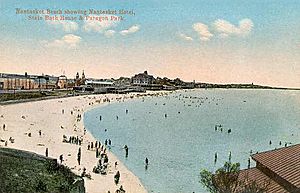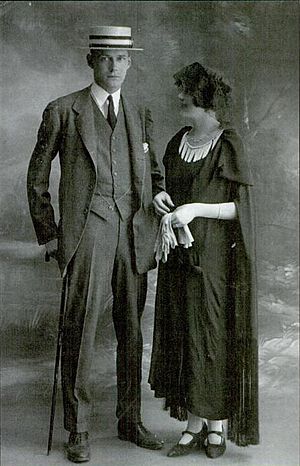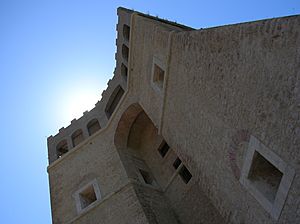Caresse Crosby facts for kids
Quick facts for kids
Caresse Crosby
|
|
|---|---|

Caresse Crosby and her whippet, Clytoris
|
|
| Born |
Mary Phelps Jacob
April 20, 1892 New York City, U.S.
|
| Died | January 24, 1970 (aged 78) Rome, Italy
|
| Nationality | American |
| Other names | Polly Jacob, Polly Peabody |
| Occupation | Publisher, activist, writer |
| Known for | Inventor of the modern bra Co-founder, Black Sun Press |
|
Notable work
|
Portfolio: An Intercontinental Quarterly |
| Spouse(s) |
Richard R. Peabody
(m. 1915; div. 1922)Selbert Young
(m. 1937; div. 1939) |
| Children | 2 |
Caresse Crosby (born Mary Phelps Jacob; April 20, 1892 – January 24, 1970) was the first recipient of a patent for the modern bra, an American patron of the arts, publisher, and the "literary godmother to the Lost Generation of expatriate writers in Paris." She and her second husband, Harry Crosby, founded the Black Sun Press, which was instrumental in publishing some of the early works of many authors who would later become famous, among them Ernest Hemingway, Archibald MacLeish, Henry Miller, Anaïs Nin, Kay Boyle, Charles Bukowski, Hart Crane, and Robert Duncan.
Contents
Early life
Born on April 20, 1891 in New Rochelle, New York, she was the oldest daughter of William Hearn Jacob and Mary Phelps, the daughter of Civil War General Walter Phelps, and she had two brothers, Leonard and Walter "Bud" Phelps Jacob. She was nicknamed "Polly" to distinguish her from her mother.
Polly's family was not fabulously rich, but her father had been raised, as she put it, "to ride to hounds, sail boats, and lead cotillions", and he lived high. In 1914, she was presented to the King of England at a garden party. And in keeping with the American aristocratic style of the times, she was even photographed as a child by Charles Dana Gibson.
She grew up, she later said, "in a world where only good smells existed". "What I wanted", she said of her privileged childhood, "usually came to pass". She was a rather uninterested student. Author Geoffrey Wolff wrote that for the most part Polly "lived her life in dreams".
Her family divided its time between estates in Manhattan at 59th Street and Fifth Avenue, in Watertown, Connecticut, and in New Rochelle, New York, and she enjoyed the advantages of an upper-class lifestyle. She attended formal balls, Ivy League school dances, and formal horse riding school. She took dancing lessons at Mr. Dodsworth's Dancing Class, attended Miss Chapin's School in New York City, and then boarded at Rosemary Hall, a prep school in Wallingford, Connecticut, where she played the part of Rosalind in As You Like It to critical acclaim.
After her father's death in 1908, she lived with her mother at their home in Watertown, CT. That same summer she met her future husband, Richard Peabody, at summer camp. Her brother Len was boarding at Westminster School, and Bud was a day student at Taft School. Approaching her own debut, she danced in "one to three balls every night" and slept from four in the morning until noon. "At twelve I was called and got ready for the customary debutante luncheon." She graduated from Rosemary Hall prep school in 1910, at age 19.
Marriages and family life


In 1915, Mary (nicknamed Polly) married Richard R. Peabody, another blue-blooded Bostonian whose family had arrived in New Hampshire in 1635. They had two children, but while her husband was away at war, she met Harry Crosby, who was seven years her junior, at a picnic in 1920. Their public affair scandalized proper Boston society. Two years later, Richard granted Polly a divorce, and Harry and Polly were married. They immediately left for Europe, where they joined the Lost Generation of American expatriates. They embraced a bohemian and decadent lifestyle, living off Harry's trust fund of US$12,000 a year (or about $205,000 in today's dollars). At her husband's urging, Polly took the name Caresse in 1924. In 1925, they began publishing their own poetry as Éditions Narcisse in exquisitely printed, limited-edition volumes. In 1927, they re-christened the business as the Black Sun Press.
With the prospect of war looming, she left Europe in 1936 and married Selbert Young, an unemployed actor 16 years her junior. They lived on a Virginia plantation they rehabilitated outside Washington, D.C., until she divorced him. She moved to Washington, D.C. and began a long-term love affair with black actor-boxer Canada Lee, despite the threat of miscegenation laws. She founded Women Against War and continued, after World War II, to try to establish a Center for World Peace at Delphi, Greece. When rebuffed by Greek authorities, she purchased Castello di Rocca Sinibalda, a 15th-century castle north of Rome, which she used to support an artists' colony. She died of pneumonia related to heart disease in Rome, in 1970.
Publish poetry and new writers
Caresse and Harry published her first book, Crosses of Gold, in late 1924. It was a volume of conventional, "unadventurous" poetry centering on the ideas of love, beauty, and her husband.
In 1926, they published her second book, Graven Images, through Houghton Mifflin in Boston. This was the only time they used another publisher. Crosby later wrote that Harry's cousin, Walter Berry, suggested that Houghton Mifflin would publish Caresse's poetry because "they have just lost Amy Lowell". Crosby's poetry remained relatively conventional, "still rhyming love with dove", by her own admission. A Boston Transcript reviewer said her "poetry sings", and a Literary Review contributor admired her "charming" child poems and French flavor. But a critic in the New York Herald Tribune wrote that "[f]or all its enthusiasm there is no impact to thought or phrase, the emotion is meager, the imagination bridled."
In April, 1927, they founded an English language publishing company, first called Éditions Narcisse, after their black whippet, Narcisse Noir. They used the press as an avenue to publish their own poetry in small editions of finely-made, hard-bound volumes. Their first effort was Caresse's Painted Shores, in which she wrote about their relationship, including their reconciliation after one of his affairs. Her writing matured somewhat, and the book was more creatively organized than her prior efforts. In 1928, she wrote an epic poem which was published as The Stranger. The writing is addressed to the men in her life: her father, husband, and son. In an experimental fashion she explored the various kinds of love she had known. Later that year, Impossible Melodies explored similar themes. The Crosbys enjoyed a positive reception from their initial work and decided to expand the press to serve other authors.
They printed limited quantities of meticulously produced, hand-manufactured books, printed on high-quality paper. Publishing in Paris during the 1920s and 1930s put the company at the crossroads of many American writers who were living abroad. In 1928, Éditions Narcisse published a limited edition of 300 numbered copies of "The Fall of the House of Usher" by Edgar Allan Poe with illustrations by Alastair.
In 1928, Harry and Caresse changed the name of the press to the Black Sun Press, in keeping with Harry's fascination with death and the symbolism of the sun. Harry developed a private mythology around the sun as a symbol for both life and death, creation, and destruction. The press rapidly gained notice for publishing beautifully bound, typographically flawless editions of unusual books. They took exquisite care with the books they published, choosing the finest papers and inks.
They published early works of a number of avant-garde writers before the writers were well-known, including James Joyce's Tales Told of Shem and Shaun (which was later integrated into Finnegans Wake). They published Kay Boyle's first book-length work, Short Stories, in 1929, and works by Hart Crane, Ernest Hemingway, Eugene Jolas, D. H. Lawrence, Archibald MacLeish, Ezra Pound, and Laurence Sterne. The Black Sun Press evolved into one of the most important small presses in Paris in the 1920s. In 1929, Polly and Harry both signed poet Eugene Jolas' The Revolution of the Word Proclamation, which appeared in issue 16/17 of the literary journal transition. After Harry died, Caresse continued publishing until 1936, when she left Europe for the United States.
Later life
Harry left Caresse US$100,000 (about $1,704,000 today) in his will, along with generous bequests to Josephine, Constance, and others. His parents Stephen and Henrietta had the will declared invalid, but reassured Caresse that she would receive US$2000 (approximately $26,000 today) a year until she received money from Walter Berry's estate. Upon her return to Europe, Poleen was brought from Chamonix by Caresse's friend Bill Sykes, Billy was brought home from boarding school by another friend, and the family and friends spent some time at the Mill. Poleen stayed with her mother for a few months, refusing to return to school. Billy returned to Choam, and in 1931 returned to the U.S. to attend the Lenox School.
Crosby retained Mary, her birth name, and was known after her husband's death as "Mary Caresse Crosby". She pursued ambitions as an actress that she had had since her 20s, and appeared as a dancer in two short experimental films directed by artist Emlen Etting, Poem 8 (1932) and Oramunde (1933). The Black Sun Press broadened its scope after Harry's death. Although it published few works after 1952, it printed James Joyce's Collected Poems in 1963. It did not officially close until Caresse's death in 1970.
Continuation of Black Sun Press
After Harry Crosby's death, Caresse dedicated herself to the Black Sun Press. She also established, with Jacques Porel, a side venture to publish paperback books when they were not yet popular, which she named Crosby Continental Editions. Ernest Hemingway, a long-time friend, offered her a choice of The Torrents of Spring (1926) or The Sun Also Rises (1926) as a debut volume for her new venture. Caresse unfortunately picked the former, which was less well received than the other volume. She followed Hemingway's work with nine more books in 1932, including William Faulkner's Sanctuary, Kay Boyle's Year Before Last, Dorothy Parker's Laments for the Living, and Antoine de Saint-Exupéry's Night-Flight, along with works by Paul Eluard, Max Ernst, Alain Fournier, George Grosz, C. G. Jung, and Charles-Louis Philippe. After six months of sales the books had only grossed about US$1200. Crosby was unable to persuade U.S. publishers to distribute her work, as paperbacks were not yet widely distributed, and then publishers were not convinced that readers would buy them. She closed the press in 1933.
Publication of Portfolio
She also published under the Black Sun Press Portfolio: An Intercontinental Quarterly, in which she sought to continue her work with young and avant-garde writers and artists. She printed issues 1, 3, and 5 in the U.S. The second issue was published in Paris in December 1945, less than seven months after the end of World War II. It featured primarily French writers and artists; the fourth issue was published in Rome and focused on Italian writers and artists; and the last issue was focused on Greek artists and writers.
During the war and for some time afterward, paper was in short supply. Caresse printed the magazine on a variety of different sizes, colors, and types of paper stock printed by different printers, stuffed into a 11.5 inches (290 mm) by 14 inches (360 mm) folder. Caresse printed 1,000 copies of each issue, and as she had done with the Black Sun Press, gave special treatment to 100 or so deluxe copies that featured original artwork by Romare Bearden, Matisse, and others. She secured contributions from a wide variety of well-known artists and writers, including: Louis Aragon, Kay Boyle, Gwendolyn Brooks, Sterling A. Brown, Charles Bukowski, Albert Camus (Letter to a German Friend, his first appearance in an English-language publication), Henri Cartier-Bresson,René Char, Paul Éluard, Jean Genet, Natalia Ginzburg, Victor Hugo, Weldon Kees, Robert Lowell, Henri Matisse, Henry Miller, Eugenio Montale, Anaïs Nin, Charles Olson, Pablo Picasso, Francis Ponge, Kenneth Rexroth, Arthur Rimbaud, Yannis Ritsos, Jean-Paul Sartre (The End of the War), Karl Shapiro, Stephen Spender, Leo Tolstoy, and Giuseppe Ungaretti. After the sixth issue, she ran out of funds and sponsors. This was her last major publishing effort.
Post-war activity
Caresse became politically active again and founded the organizations Women Against War and Citizens of the World, which embraced the concept of a "world community", which other activists such as Buckminster Fuller also supported. Caresse continued her work to establish a world citizen's center in Delphi, Greece, where in 1942 she bought a small house that overlooked the Grove of Apollo. In October 1952, she attempted to visit her property, but she was met by armed guards at Corfu as she got off the ferry from Brindisi. The police placed her under house arrest in the Corfu Palace Hotel, and after three days they told her she was not welcome in Greece and ordered her to leave. The American consul told her that the Greek government thought she was still "considered dangerous to the economy and politics of Greece." When her plan failed, she sought to create the "World Man Center" in Cyprus, which was to include a geodesic dome designed by Fuller. This effort, too, came to naught, and she continued to search for a center for her world citizen project.
In 1953, Caresse wrote and published her autobiography.
Support of artist's colony
She was first introduced to a run-down castle named Castello di Rocca Sinibalda 70 kilometres (43 mi) north of Rome in 1949 during a tour of Italy. It had been designed by Baldassare Peruzzi and was built between 1530 and 1560 for Cardinal Alessandro Cesarini. In the 1950s she rented it, and later paid US$2,600 (about $24,533 today) for the estate. It came with the Papal title of Principessa (Princess). She paid to electrify the castle and thus brought electricity to the neighboring village. She told a reporter that the castle had 320 rooms, "at least that's what the villagers tell me." (The deed listed 180 rooms.) Many of the rooms had 21 feet (6.4 m) ceilings and the palace was virtually impossible to heat. "I wouldn't live here if you paid me," she told a reporter.
The residential portion of the palace contains three main apartments and two courtyards. The walls of the main hall are decorated by frescoes from the 16th century. She used the castle to support various artists, including poets' seminars. Henry Miller described Rocca Sinibalda as the "Center for Creative Arts and Humanist Living in the Abruzzi Hills." Other artists visited for a weekend or an entire season.
In 1962, filmmaker Robert Snyder made a 26-minute documentary about Caresse's history and her plans for the castle. The short film, Always Yes, Caresse took the viewer on a tour of the castle, led by Caresse. At one point in the film, she pulled down her blouse to reveal her ample bosom. He learned about the writer's retreat when he was in Rome filming a documentary on the Sistine Chapel, The Titan; The Story of Michelangelo.
Caresse for a time divided her time between Rocca Sinibalda, which in the winter was too cold and unlivable, Hampton Manor in Bowling Green, Virginia, a home in Washington, D.C., a sprawling apartment at 137 East 54th Street in New York City, as well as a residence in Rome. In 1953, Alvin Redman published her autobiography, The Passionate Years. She put Rocca Sinibalda up for sale in 1970, shortly before she died.
Death
Caresse died from complications from pneumonia in Rome, Italy on January 24, 1970, aged 78.
Her first two husbands and her son Bill preceded her in death. She was survived by her daughter Polleen Peabody de Mun North Drysdale and two granddaughters. Crosby was buried in the Cimetière de l'Abbaye de Longchamp, in Boulogne, département de la Vendée, Pays de la Loire, France.
Legacy
The bra she invented went through a number of transformations and became a standard undergarment for women all over the world.
Most of her papers and manuscripts are held in the archives of the Southern Illinois University Special Collections Research Center in the Morris Library at Southern Illinois University in Carbondale, Illinois, including more than 1600 photographs from her life, along with the papers of her friends James Joyce and Kay Boyle.
In 2004, Fine Line Features optioned Andrea Berloff's first screenplay Harry & Caresse. Lasse Hallström was initially attached to direct and Leslie Holleran was attached as a producer.
Works
As author
- Crosses of Gold Éditions Narcisse, Paris, 1925
- Graven Images, Houghton Mifflin, Boston, 1926
- Painted Shores Black Sun Press, Paris, 1927
- The Stranger Black Sun Press, 1927
- Impossible Melodies Black Sun Press, 1928
- Poems for Harry Crosby Black Sun Press, 1930
- The Passionate Years Dial Press, 1953
As editor
- Portfolio: An Intercontinental Quarterly Six editions, Washington, D. C.
See also
 In Spanish: Caresse Crosby para niños
In Spanish: Caresse Crosby para niños




